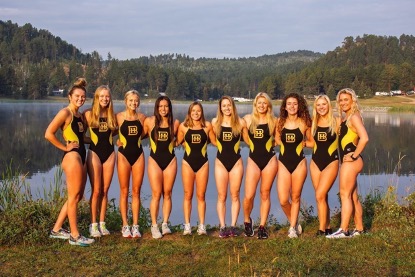Black Hills State University Athletics recognizes Title IX’s 50-year anniversary

The Education Amendments in June of 1972 prohibited sexual discrimination of any federal financially assisted educational program or activity. Title IX is applied to around 17,600 school districts and 5,000 universities or colleges in the nation.
The federal law is most typically known for its representation in college athletics. Requiring for men and women to be provided with equal opportunity to participate in sports. Athletic organizations must show efforts to balance out the male-to-female ratio in programs compared to the campus’ male-to-female ratio. Schools are also required to proportion scholarship dollars to men and women athletics evenly. Organizations must additionally provide equal treatment in provisions of equipment, scheduling, allowance, facilitates, publicity, and services to male and female athletes.
According to Encyclopedia Britannica, “All colleges are required to submit information each year about their athletic programs to determine compliance with Title IX.”
Leveled ground between female and male athletics in colleges and universities created equal opportunity. In 2019, the National College Athletic Association totaled that out of all college athletes, 56 percent are male athletes and 44 percent are female athletes. That is almost a 600 percent increase since before Title IX was in affect during the early 1970’s.
BHSU has six male sports teams and eight female sports teams. The programs split is determined from the 63 percent female population makeup of the college. BHSU men’s football makes up around 100-130 male athletes compared to women’s sports teams with an average of 15 players a team. There tends to be more female sports needed at BHSU because of the amount of male players sports like football field.
Athletes with an increased understanding of Title IX are vital to the historic roll it has created. At BHSU the administration makes sure students are given the resources to further educate themselves on the law with meetings and training.
BHSU sophomore volleyball player, Jessica Crane, comments on BHSU’s commitment to educating athletes on Title IX, “We talk all the time, and go to meetings about sexual discrimination. I feel the school does a good job about informing us.”
One massive problem women’s athletics still faces in the equal treatment in provisions of exposure and publicity. Many sports such as football might generate more exposure because of publicity. Publicity and exposure have generated more revenue for team’s like basketball and football. A team’s or program’s success is also dictated by funds from donors and money generated through publicity. Exposure has helped support funds and costs by creating a larger fan base. Larger fan bases for a program means a larger target market for funding and marketing eventually generating more revenue to spend.
Madee Hoopman, BHSU senior volleyball player considers the problems that continue to exist with Title IX. Hoopman highlights the problems with conflicting schedules for home events causing a lack of support for certain teams. Such as both men’s and women’s basketball games being played back-to-back or volleyball games being played as home football games end. More consideration may be needed when deciding home sporting events for teams that need a better opportunity for generating revenue though publicity and exposure.

Title IX hits a 50-year mark as BHSU and similar institutions commemorate and discuss the importance of the legislation. Title IX has not resulted with an immediate end to sexual discrimination within college programs, but has set a foundation for equal opportunities in-favor-of all athletes.

